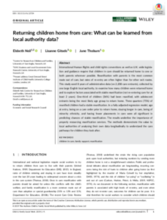Abstract
International Human Rights and child rights conventions as well as U.K. wide legislation and guidance require that children in care should be returned home to one or both parents wherever possible. Reunification with parents is the most common route out of care, but rates of re-entry are often higher than for other exit routes. This study used 8 years of administrative data (on 2,208 care entrants), collected by one large English local authority, to examine how many children were returned home and to explore factors associated with stable reunification (not re-entering care for at least 2 years). One-third of children (36%) had been reunified, with adolescent entrants being the most likely age group to return home. Three quarters (75%) of reunified children had a stable reunification. In a fully adjusted regression model, age at entry, being on a care order prior to return home, staying longer in care, being of minority ethnicity, and having fewer placements in care were all significant in predicting chances of stable reunification. The results underline the importance of properly resourcing reunification services. The methods demonstrate the value to local authorities of analysing their own data longitudinally to understand the care pathways for children they look after.

